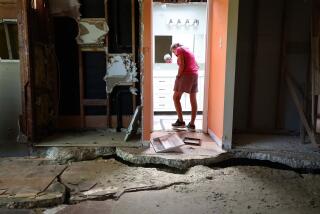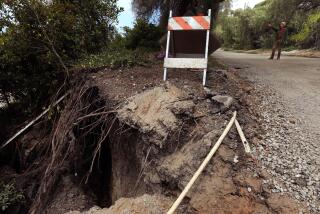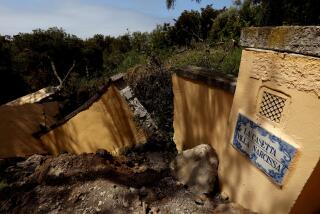Warning: Hills Can Slide, Even on the Sunniest Days
- Share via
A hill collapse closed Laurel Canyon Boulevard and ground instability prompted the city to red-tag Frank Lloyd Wright’s landmark Ennis-Brown House as mudslides continued to trigger evacuations Monday despite five days of dry weather.
Geologists said the mudslide danger could last for several months, even if little more rain falls. Water that has saturated hillsides this winter is sinking deeper into the ground, creating the potential for soil shifts that could trigger more collapses.
They pointed out that the 1995 mudslide in the La Conchita community in Ventura County that destroyed several homes occurred two months after the rains had stopped.
“The sun is shining, but the rain is busily percolating downward,” said Randy Jibson, a geological consultant for the U.S. Geological Survey.
“You can’t see it, but it’s busy. I expect that in the next few months, we will see a spectrum of landslides -- deeper, slow-moving landslides -- throughout the region. They don’t kill people, but they cause enormous property damage. You can sit there and listen to a house creaking and groaning, and you’re helpless,” he said.
Southern California has been battered by a series of heavy rainstorms that dumped more than 33.8 inches of rain so far this season, making it one of the wettest on record. Some meteorologists expect the 2004-05 season to eventually top the wettest on record, 1883-84, when 38.18 inches fell.
Officials on Monday were trying to determine the extent of the damage to the Wright creation, a massive concrete compound perched in the hills of Los Feliz just below the Griffith Observatory.
The house has had structural problems in the past, and there were signs Monday that portions of the massive Maya-inspired retaining wall were weakened by the rains. Several other homes in the area also have been red-tagged.
Los Angeles building inspectors determined the Ennis-Brown House was uninhabitable Saturday when they discovered that part of the wall behind the house was crumbling, said Bob Steinbach, a spokesman for the city’s Department of Building and Safety.
Inspectors estimated that rain and mud have caused at least $500,000 damage to the house so far, he said.
The problems come as the Trust for Preservation of Cultural Heritage, a nonprofit, was embarking on a major effort to restore the compound, which has been deteriorating because of age as well as several nature diasters, including the 1994 Northridge earthquake.
The nearly 10,000-square-foot home is made of more than 24,000 patterned, perforated and smooth concrete blocks that contain decomposed granite extracted from the site.
A few miles to the west, a hill gave way at the entrance to Laurel Canyon Boulevard near Mount Olympus Drive, causing the city to close a key route between the San Fernando Valley and the Westside and to evacuate several houses along Laurel Canyon Boulevard. Commuters had to find other routes through the Hollywood Hills.
Officials said three houses were red-tagged, meaning no one was allowed in, and three were yellowed-tagged, meaning residents had only limited access.
As of Monday, more than 80 residences had been red-tagged in Los Angeles alone. Several other hillside communities have also reported severe damage to residences, including Culver City, Pasadena, Glendale, Anaheim and Laguna Beach.
Four houses in the Phillips Ranch section of Pomona were red-tagged last week after the slope below them began to give way and the structures started crumbling.
In Diamond Bar, a hillside slid a quarter-mile, carrying trees and debris into the backyards of neighboring houses. City officials said many of them were built before the city incorporated in 1989, before more stringent standards were in place.
Mudslides are caused by oversaturated ground that is absorbing water deeper and deeper, creating a powerful force beneath the surface that can carry cars, houses and people away.
Geologists expect to see this pattern continue at least through May.
“Failures can happen months after rains because of the permeability and the slope and other related things,” said Doug Morton, a retired geologist for the U.S. Geological Survey.
The passage of time after a rainstorm reduces the chances that a slide will occur, Jibson said, but if one does happen, it is likely to be relatively large.
“The deeper the water has infiltrated the ground, the deeper the slides,” he said. “But it’s been longer, so it’s less likely it will happen.”
Generally, 10 inches of rain marks the point at which mudslides start occurring in Southern California, Jibson said. Because rain started to fall earlier than usual this season -- October instead of November -- water absorption was accelerated.
“We’re not out of the woods yet in La Conchita and similar places,” Jibson said, referring to the community where a massive mudslide in January killed 10 people. “We could very well in the next few weeks or months see deeper landslides in other parts of the neighborhood.”
More to Read
Sign up for Essential California
The most important California stories and recommendations in your inbox every morning.
You may occasionally receive promotional content from the Los Angeles Times.










